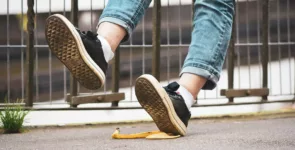Accidents happen every day, often when we least expect them. A common type of accident involves slipping or tripping, which can lead to serious injuries. Understanding the difference between slip and fall and trip and fall injuries is important. A slip and fall typically occurs when a person loses footing on a slick surface. It might be a wet floor or an icy sidewalk. On the other hand, a trip and fall happens when something stops your forward movement, like a raised sidewalk or uneven carpet. Each has unique causes and effects on the body. Recognizing these differences can help in preventing accidents and managing injuries if they occur. The D2 Law Firm team emphasizes the importance of awareness in these situations. By knowing the distinct characteristics of each, better safety measures can be put in place. This knowledge can also aid in seeking appropriate medical attention and legal aid if necessary.
What Causes Slip and Fall?
Slip and fall incidents usually arise from wet or polished surfaces. They can also happen on icy surfaces or when liquids spill onto floors. Poor lighting can make these hazards even more dangerous. Shoes with inadequate grip can increase the risk. According to the Centers for Disease Control and Prevention (CDC), slips contribute significantly to accidents in homes and workplaces.
What Causes Trip and Fall?
Trip and fall accidents often occur when an object unexpectedly interrupts your path. It can be a loose rug, a raised edge on a walkway, or a cluttered floor. Poor visibility is another contributing factor. This type of accident can also occur when walking on uneven surfaces or climbing stairs. Ensuring pathways are clear and well-lit can help reduce these incidents.
Comparing Slip and Fall and Trip and Fall Injuries
Understanding the differences between these two types of falls can help in prevention and treatment. Here is a simple comparison:
| Criteria | Slip and Fall | Trip and Fall |
| Typical Cause | Slick Surface | Obstruction in Path |
| Common Injuries | Back and Head Injuries | Foot and Leg Injuries |
| Prevention Measures | Improve Surface Grip | Clear Walkways |
Common Injuries from Falls
Both slip and fall and trip and fall incidents can lead to injuries. Slip and fall often result in back, wrist, and head injuries. In contrast, trip and fall accidents frequently cause injuries to the knees, elbows, and face. Fractures and bruises are common in both cases. Some injuries may require immediate medical attention, while others might need long-term care.
Preventative Measures
Preventing falls requires vigilance and proactive measures. Here are three steps you can take:
- Keep walkways clear and well-lit.
- Use rugs with non-slip backing on smooth floors.
- Wear shoes with proper grip, especially on wet or icy surfaces.
Seeking Help After a Fall
If an accident occurs, it’s crucial to seek medical attention. This ensures you receive necessary care and helps document the incident. Consulting with a legal professional, like the D2 Law Firm team, can guide you in understanding your rights and options. Knowing when to reach out for help can make a significant difference in recovery.
Conclusion
Understanding the differences between slip and fall and trip and fall accidents is essential for prevention and treatment. Simple steps and precautions can reduce risks significantly. If an accident does happen, knowing how to respond can aid in recovery and ensure proper handling of any legal considerations. Staying informed and prepared helps in maintaining a safe environment.
Written by Lara Harper








